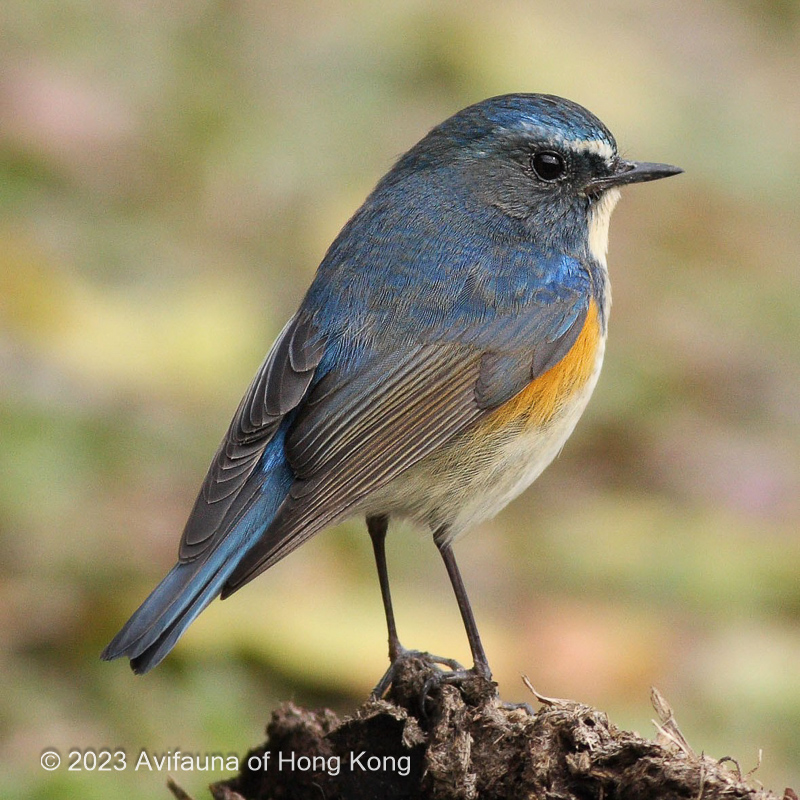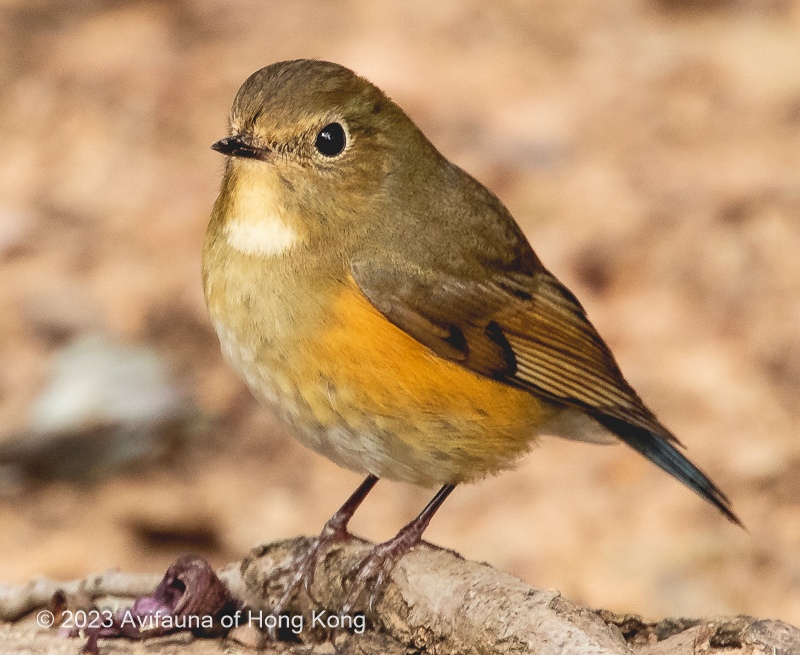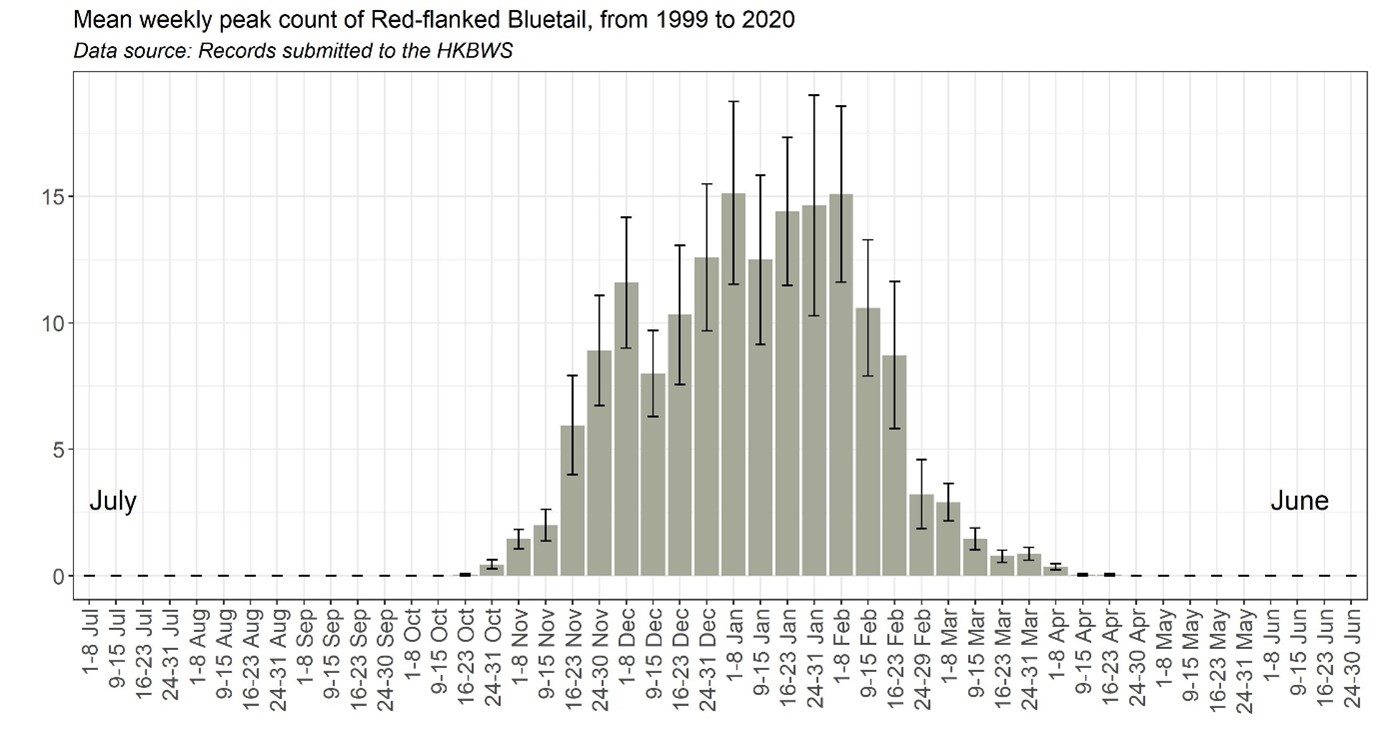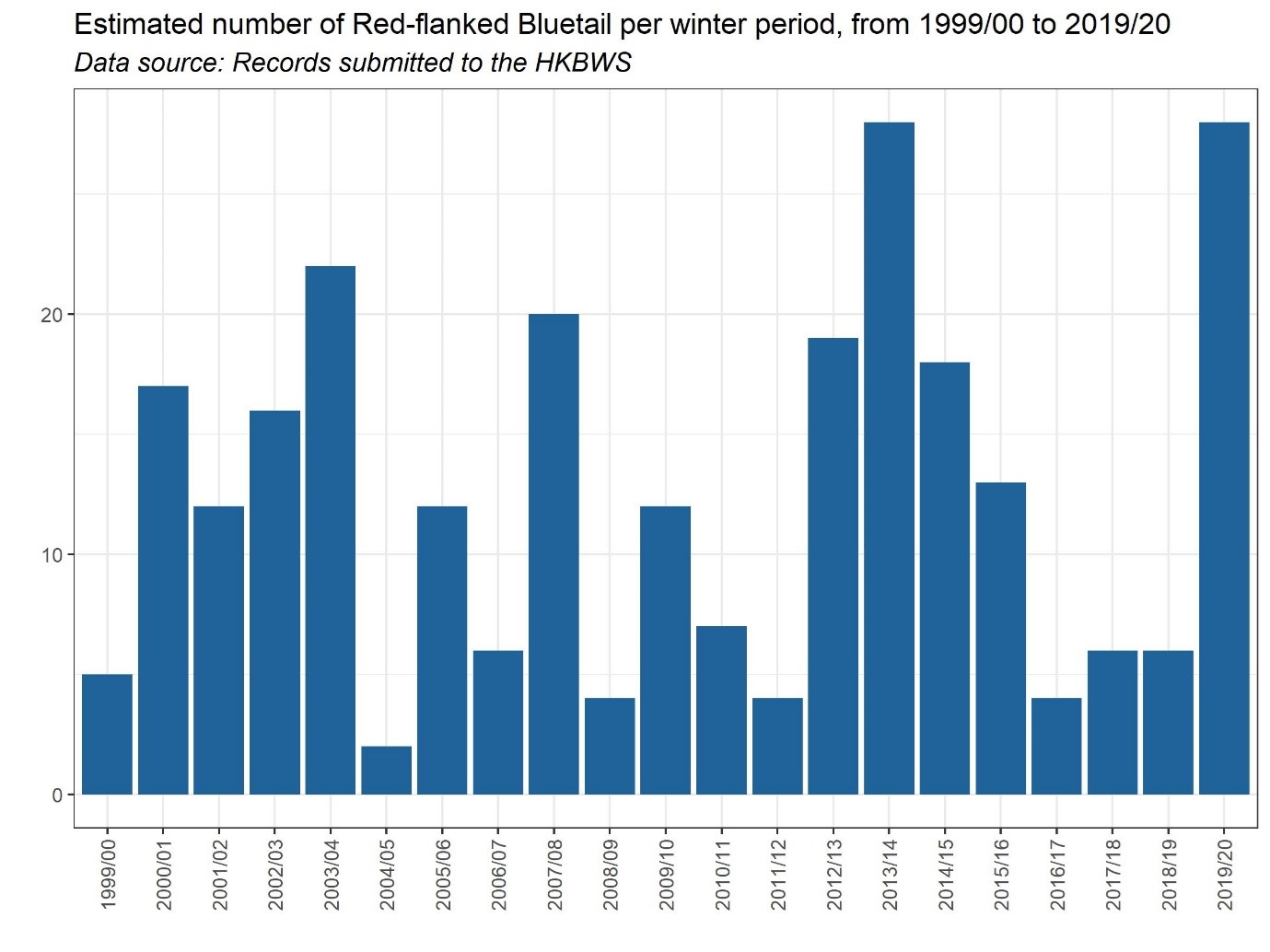Red-flanked Bluetail Tarsiger cyanurus 紅脇藍尾鴝
Category I. Fairly common winter visitor to closed-canopy shrubland and woodland; passage migrants are scarce and occur in more open habitats; numbers vary considerably from year to year.
IDENTIFICATION

Feb. 2008, FUNG Hon Shing.
13-14 cm. Adult male readily identified by its blue upperparts, white supercilium, white throat and underparts, and orange flanks. Dull greyish tips to upperpart feathers abrade during winter.

Feb. 2020, David Diskin.
Adult females and first-winters, including first-winter males, are very similar and are difficult to separate in the field. They are olive-brown above and have a blue rump and tail. The white throat stands out above a brown breastband. The rest of the underparts are white; the flanks are orange-rufous.
VOCALISATIONS
Fairly vocal, giving two calls which may or may not be uttered in succession. The first is a moderately high-pitched ‘sweet’ while the second is a moderately low-pitched ‘tuk’ usually uttered as a double note, though can be more or fewer.
May be confused with similar calls of Daurian Redstart when the two are present in the same area. Compared to the latter, the high-pitched call is slightly lower-pitched and has an obvious inflection, while the ‘tuk’ call is lower in pitch, and when uttered as a pair of notes the gap between the pairs is slightly longer.
A low-intensity version of the song is rarely heard in late autumn or early spring.
DISTRIBUTION & HABITAT PREFERENCE
Highest densities of Red-flanked Bluetail occur in closed-canopy woodland and shrubland. It had the highest relative abundance (15.7%) among non-breeding migrant species trapped in shrubland by Leven (2000).
It can be found throughout HK, including the outlying islands; also occurs in urban edge habitats with sufficient cover such as Ho Man Tin. It prefers the darker areas of the forest, though in cold weather will readily come out to the sunlit edge.
The winter atlas surveys of 2001-05 recorded Red-flanked Bluetail in 23.4% of 1km squares, whereas the 2001-05 survey only recorded it in 5.1% of squares. The decline occurred throughout HK, but particularly in sub-optimal habitat in the Deep Bay area and west New Territories. As this is a species the bulk of whose population winters to the north of HK, it is possible that milder winters arising from climate change have allowed more birds to winter further north. However, it is also possible that habitat changes on the Siberian breeding grounds may have reduced population size.
OCCURRENCE
Winter visitor, abundance varying from scarce to common apparently depending on how cold the winter. Extreme dates are 23 October and 17 April.
Only small numbers occur before the third week of November (Figure 1), after when there is a considerable increase in abundance. Ringing in the 1990s revealed a high turnover of birds in late November and early December indicating onward passage. In autumn 1995, for example, 71 different individuals were netted, the highest number processed on a single day being 13 on 25 November.
However, the greatest numbers occur as winter visitors from late December to the first week of February. Departure occurs from the second week of February, and the species is scarce from the final week of the month, with very few records of migrants in April.
Numbers vary considerably (Figure 2). Between 1999/2000 and 2019/20 there were seven winter periods where the estimated total number of individuals recorded in HK was in single digits, including four particularly poor seasons (1999/2000, 2004/05, 2008-09 and 2011/12). This is in contrast to much higher numbers in 2013/14, 2015/16 and 2019/20, though these are no doubt influenced by increased observer activity.
Many reports are of single birds but several or more may be found in the same general area. The highest count on record is 39 at Kadoorie ARC on 21 January 1992. The highest count since 1999 is 28 at Tai Lam Country Park on 1 January 2014 and between Shing Mun and Tai Po Kau on 29 January 2020. The January dates of all these records are indicative of midwinter influxes usually associated with cold weather. Most birds are first-winters or females; males tend to be more numerous during periods of cold weather, suggesting they normally winter further north.
Ringing activities in the 1990s established that many individuals show intra-seasonal site-fidelity but there were only two instances of inter-seasonal retraps: one ringed at Kadoorie ARC on 1 January 1994 was controlled on 22 December 1995 and again on 6 January 1996, and one ringed at the same site on 7 January 1995 was retrapped on 8 January 1997.
A female shot at Mong Tseng on 25 January 1936 (Herklots 1936) was the first record for HK. Subsequently, Herklots (1953) regarded it as a winter visitor from 25 November to 19 March.
BEHAVIOUR, FORAGING & DIET
Can be shy and elusive, particularly in thicker forest where presence is often revealed by its call. It is usually more visible and approachable in periods of cold weather when food supply is scarce. Constantly flicks its tail. Forages on invertebrates by dropping down to the ground from a low-level perch but may also seek prey in bushes or below the canopy for prolonged periods. One came to the balcony of a village house at Sheung Shui for about two weeks in January 2003 to feed on mealworms. Two were seen feeding on the fruit of Mallotus paniculatus at Tai Lam Country Park on 1 January 2014.
RANGE & SYSTEMATICS
Monotypic. Breeds from from Finland east across central Siberia, Mongolia and northeast China (Inner Mongolia and Heilongjiang) to Kamchatka and northern Japan. It winters in south Japan, South Korea, east and southeast China (as far north as Beijing, though mainly south of the Yangtze from Taiwan west to Hainan and Yunnan), Myanmar, northern Thailand, Laos and Vietnam (Collar et al. 2020, Liu and Chen 2020).
CONSERVATION STATUS
IUCN: Least Concern. Population trend stable.
Figure 1.

Figure 2.

Birding Beijing (2022). https://birdingbeijing.com/the-status-of-the-birds-of-beijing/ (Accessed 3 August 2022).
Collar, N., E. de Juana, and D. A. Christie (2020). Red-flanked Bluetail (Tarsiger cyanurus), version 1.0. In Birds of the World (J. del Hoyo, A. Elliott, J. Sargatal, D. A. Christie, and E. de Juana, Editors). Cornell Lab of Ornithology, Ithaca, NY, USA. https://doi.org/10.2173/bow.refblu.01
Herklots, G. A. C. (1936). Notes and comments. Ornithology. Hong Kong Naturalist 7: 81-86.
Herklots, G. A. C. (1953). Hong Kong Birds. South China Morning Post, Hong Kong.
Leven, M.R. (2000). Shrubland birds in Hong Kong: community structure, seasonality and diet. Ph. D thesis, University of Hong Kong.
Liu, Y. and Y. H. Chen (2020). The CNG Field Guide to the Birds of China (in Chinese). Hunan Science and Technology Publication House.

